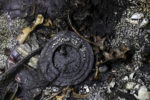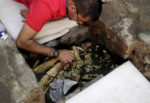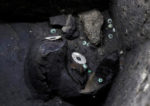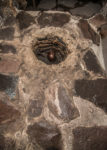 The excavation at the foot of the steps of the sixth stage of the Templo Mayor in Mexico City that discovered the remains of a sacrificed child last year has unearthed a new trove of rich sacrificial offerings including jaguar bones, a set of flint knives, copal bars, shells and starfish.
The excavation at the foot of the steps of the sixth stage of the Templo Mayor in Mexico City that discovered the remains of a sacrificed child last year has unearthed a new trove of rich sacrificial offerings including jaguar bones, a set of flint knives, copal bars, shells and starfish.
The jaguar bones were found in a rectangular stone box that is so large Archaeologists from Mexico’s National Institute of Anthropology and History (INAH) have barely scratched the surface so far.
Only about one-tenth of the box’s contents has been excavated, but already a wide array of artefacts has been found near the top, including a spear thrower and a carved wooden disk placed on the feline’s back that was the emblem of the Aztec patron deity Huitzilopochtli, the war and sun god.
A layer of aquatic offerings placed on top of the west-facing jaguar have also been identified, including a large amount of shells, bright red starfish and coral that likely represented the watery underworld the Aztecs believed the sun travelled through at night before emerging in the east to begin a new day.
A roseate spoonbill, a pink bird from the flamingo family, has also been found in the offering. It was associated with warriors and rulers, and thought to represent their spirits in their descent into the underworld.
 A second stone box was discovered next to the jaguar box. It contains a top layer of copal bars, a type of tree resin burned by Aztec priests like frankincense and sea shells. It has only been partially excavated thus far. A third stone box next to it contains 21 flint knives that, like the remains of the jaguar and the young boy, were decorated with the regalia of warriors complete with a mother of pearl war god disc, a miniature spear thrower and a shield.
A second stone box was discovered next to the jaguar box. It contains a top layer of copal bars, a type of tree resin burned by Aztec priests like frankincense and sea shells. It has only been partially excavated thus far. A third stone box next to it contains 21 flint knives that, like the remains of the jaguar and the young boy, were decorated with the regalia of warriors complete with a mother of pearl war god disc, a miniature spear thrower and a shield.
 The ongoing discoveries of ritually significant offerings at the site while exciting in and of themselves also tender hope that this spot could indeed be the tomb of Aztec king Ahuízotl. According to Spanish chronicles, cinerary remains of three Aztec kings of Tenochtitlan — brothers Axayacatl (1469–1481), Tizoc (1481–1486) and Ahuízotl (1486-1502) — were deposited along with copious offerings and the hearts of sacrificial victims under or near the Cuauhxicalco, a circular platform at the foot of the steps of the Templo Mayor. This is where the pit containing the remains of the sacrificed boy and now the rectangular box have been found.
The ongoing discoveries of ritually significant offerings at the site while exciting in and of themselves also tender hope that this spot could indeed be the tomb of Aztec king Ahuízotl. According to Spanish chronicles, cinerary remains of three Aztec kings of Tenochtitlan — brothers Axayacatl (1469–1481), Tizoc (1481–1486) and Ahuízotl (1486-1502) — were deposited along with copious offerings and the hearts of sacrificial victims under or near the Cuauhxicalco, a circular platform at the foot of the steps of the Templo Mayor. This is where the pit containing the remains of the sacrificed boy and now the rectangular box have been found.
 The cylindrical burial pit is unique among the 204 tombs unearthed at the Templo Mayor, and with the exceptional density of sacrificial offerings that have already been found in the stone box, archaeologists are hoping that they may have indeed found the burial site of the kings described by the Spanish. The construction phase of the temple dates to the reign of Ahuízotl, so all the pieces seem to fit. If the archaeologists’ hopes come to fruition, this would be the first tomb of an Aztec ruler that has ever been found.
The cylindrical burial pit is unique among the 204 tombs unearthed at the Templo Mayor, and with the exceptional density of sacrificial offerings that have already been found in the stone box, archaeologists are hoping that they may have indeed found the burial site of the kings described by the Spanish. The construction phase of the temple dates to the reign of Ahuízotl, so all the pieces seem to fit. If the archaeologists’ hopes come to fruition, this would be the first tomb of an Aztec ruler that has ever been found.
Well, that looks like a career’s worth of sorting there!